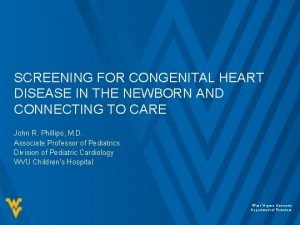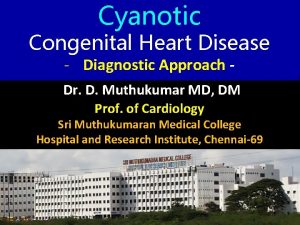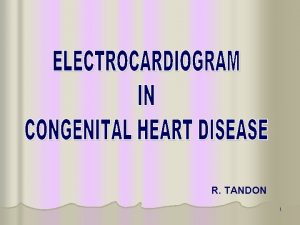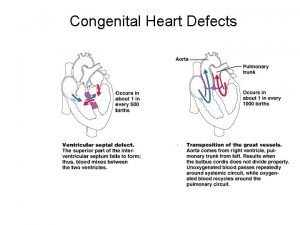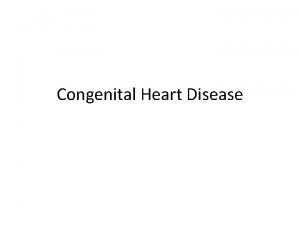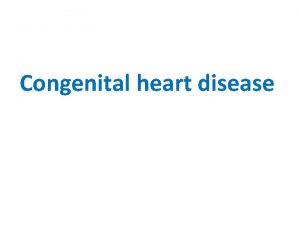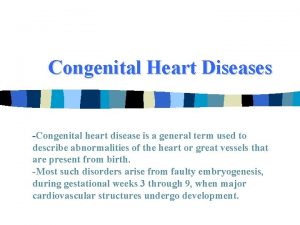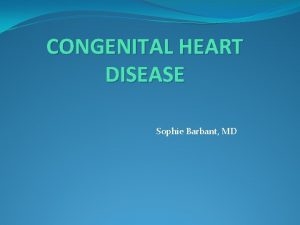Congenital Heart Disease Hemiparesis Congenital Heart Disease Congenital








- Slides: 8

Congenital Heart Disease & Hemiparesis

Congenital Heart Disease Congenital heart disease (CHD) is the most common type of birth defect. CHD refers to a problem with the heart’s structure that occurred because of abnormal development in the heart before birth. CHD consists of 2 categories: Cyanotic CHD and Acyanotic CHD is a risk factor for emboli development which can contribute to cerebrovascular accidents.

Occurrence & Risk Factors • Most cases of CHD occur in isolation • CHD can be associated with various genetic disorders such as Down Syndrome, Marfan Syndrome, Turner Syndrome and Trisomy 13 • Risk factors: ▫ Associated with maternal intake of retonic acid (for acne), alcohol, chemical exposure and rubella

Acyanotic CHD • Presentation ▫ Pink in coloring ▫ Normal oxygenation saturation ▫ Involves left-to-right shunting so that oxygen rich blood is shunted to the lungs unnecessarily ▫ Defects associated with acyanotic CHD �Atrial septal defect �Ventricular septal defect �Patent ductus arteriosus �Aortic coarctation �Pulmonary stenosis �Aortic stenosis

Cyanotic CHD • Presentation ▫ Cyanosis (blue) in coloring ▫ Oxygen saturation is 15 to 30% below normal ▫ Involves right-to-left shunting so that unoxygenated blood is shunted to the body ▫ Defects associated with CCHD �Tetralogy of Fallot (TOF) �Transposition of the Great Artery �Tricuspid Atresia �Pulmonary atresia �Truncus Arteriosus �Total Anomalous Pulmonary Venous Return �Hypoplastic Left-Sided Heart Syndrome

Hemiparesis and CHD • In study of children with brain abscesses, one pre-disposing factor was unoperated CCHD. This group of children with CCHD tended to have more significant cerebral complications (midline shift and cerebral edema) following drainage of the abscess. Other complications included hemiparesis and seizures for this group.

Cerebrovascular Accidents and CHD • 1/5 to 1/3 of ischemic childhood strokes can be attributed to underlying congenital heart defects • Due to paradoxical cerebral emoblism: emboli from the systemic venous circulation passes to arterial circulation from large septal defects, single ventricle, total anomalous pulmonary venous return, truncus arteriosus ▫ Single ventricle physiology with right-to-left shunting is especially vulnerable to systemic emboli

References • Kirton A, De. Veber G. Ischemic stroke complicating pediatric cardiovascular disease. Nat Clin Pract Cardiovasc Med. 2007 Mar; 4(3): 163 -6. • Mehnaz A, Syed AU, Saleem AS, Khalid CN. Clinical features and outcome ofcerebral abscess in congenital heart disease. J Ayub Med Coll Abbottabad. 2006 Apr-Jun; 18(2): 21 -4. • Salih MA, Al-Jarallah AS, Abdel-Gader AG, Al-Jarallah AA, Al-Saadi MM, Kentab AY, Alorainy IA, Hassan HH. Cardiac diseases as a risk factor for stroke in Saudi children. Saudi Med J. 2006 Mar; 27 Suppl 1: S 61 -8. • Wu YW, Lynch JK, Nelson KB. Perinatal arterial stroke: understanding mechanisms and outcomes. Semin Neurol. 2005 Dec; 25(4): 424 -34. Review.

